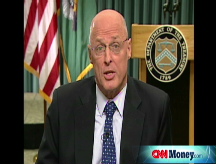Get used to high prices
The Fed has a mandate to keep inflation in check. But global forces and worries about the U.S. economy will keep prices high for the foreseeable future.
| |
|
|
NEW YORK (CNNMoney.com) -- For those struggling to deal with record gasoline and soaring food prices, there's bad news and more bad news.
Economists think inflation is here to stay. And it's likely to get worse.
A weak dollar and growing economies in emerging markets have conspired to send commodity prices higher. Those factors are unlikely to change anytime soon.
"We're more open to influences from the rest of the world than we were before," said Jay Bryson, international economist with Wachovia. "That does make it more challenging to keep inflation under control."
What's more, the Federal Reserve is relatively powerless to deal with many of these pressures.
"The Fed can't control prices of commodities determined in a global market," said Rich Yamarone, director of economic research at Argus Research. "If it could, it would have done so already."
On Friday, the Labor Department reported its latest reading on inflation. The Consumer Price Index (CPI) rose 0.6% in May. Economists were expecting a 0.5% increase according to Briefing.com. This was the biggest jump in a year. And over the past twelve months, prices are up 4.2%.
The so-called core CPI, which excludes food and energy, also picked up speed. It rose 0.2%, in line with forecasts. The core CPI was up 0.1% in April.
And the June CPI numbers could wind up showing even bigger gains. So far this month, retail gasoline prices have hit a series of record highs and topped $4 a gallon for the first time.
Futures prices for oil and key commodities such as corn have also climbed to record levels. Corn futures shot above $7 a bushel for the first time Wednesday as flooding in the Midwest trimmed forecasts for this year's harvest.
But it's not just oil and food that are leading to higher prices for consumers. A separate inflation reading reported Thursday showed the price of imports, excluding oil, were up 6.6% in the 12 months ending in May. That's the highest increase in that measure in 20 years.
A weak dollar has overseas exporters demanding more greenbacks for their goods.
Rapid growth of manufacturing and services overseas has workers in developing economies such as China and India winning healthy wage increases. That also raises prices of those countries' exports.
In addition, those countries have seen robust gains in auto sales, which should lead to even more demand for oil in the years ahead.
Another factor lifting prices is a weaker dollar. The dollar has lost about 13% of its value compared to the euro since August. This means it takes more dollars to bid for commodities against traders in Europe and Asia.
Much of the weakness in the dollar has been laid at the feet of the Fed, which has slashed interest rates seven times since September. At the same time, central banks elsewhere have made only small cuts to their interest rates.
And even with the Fed now signaling it is likely to keep rates steady in the near term, the dollar has continued to slide as the head of the European Central Bank suggested that the ECB would raise rates soon. Those comments sent oil soaring to a record close of $138.54 on Friday.
Oil analyst Peter Beutel, president of Cameron Hanover, said he believes 90% of the rise in oil prices since last August was due to the Fed's rate cuts and the expectations of rate hikes in Europe.
"If the dollar was where it was last August, there's a very good chance we might never have seen $100 a barrel oil, maybe not even $90," he said.
The Fed, which has a mandate to keep prices in check, has been voicing greater concern about inflation in recent weeks. Most recently, Fed Chairman Ben Bernanke said Monday there is an increased risk of high food and energy bleeding through to the price of other goods and services.
But most economists don't expect the Fed to raise interest rates -- its traditional way of combating inflation -- until the end of the year at the earliest.
Generally, higher rates cool U.S. economic activity and cut demand for goods and services, which in turn leads to lower prices.
However, the Fed also has a mandate to foster sustainable economic growth. And with the unemployment rate registering its biggest spike in 22 years in May, the Fed is not likely to push rates higher soon, economists said.
There's also the fact that the Fed typically prefers to stay on the sidelines in the middle of a presidential election.
"I think you'll see the Fed talk up a storm about the caustic nature of inflation, because that's all they can do now, at least until the election is over," said Yamarone.
To that end, investors are currently pricing only a 20% chance of a hike at the Fed's next meeting, a two-day session that concludes on June 25.
Others say the Fed also has to be worried about the reaction of financial markets if it made a sharp and sudden move to raise rates.
"The Fed is painted into a corner," said Barry Ritholtz, CEO and director of equity research for Fusion IQ. "They don't dare raise rates. The credit crisis is not even remotely behind us. So the Fed has limited options and there's only so much they can do."
With that in mind, Wachovia's Bryson thinks that inflation will peak in the third quarter of the year with an annual rate of 4.3%. Yamarone sees consumer prices getting as high as 5% annually.
But Bryson said even if the rate of price increases retreat late in the year, the new floor for prices will be a lot higher than they used to be.
"Corn and oil are not going to go back to where they were a few years ago," he said. ![]()




